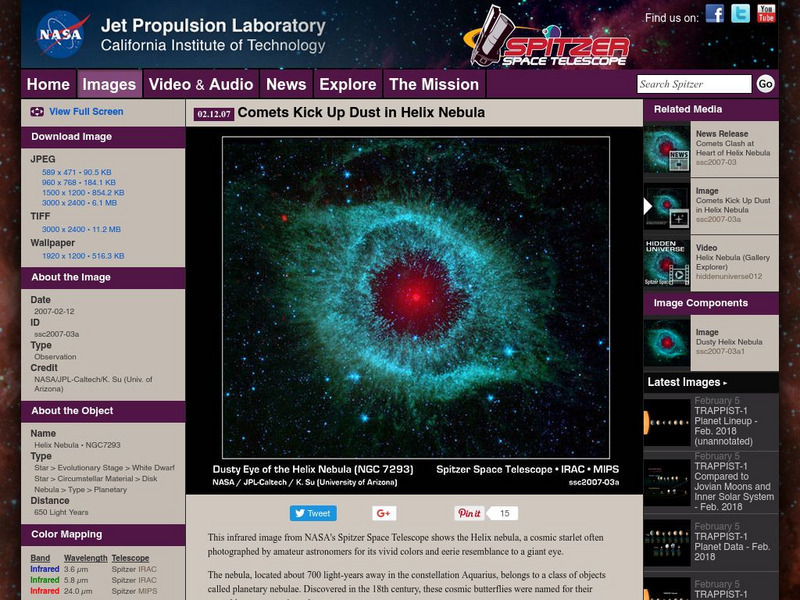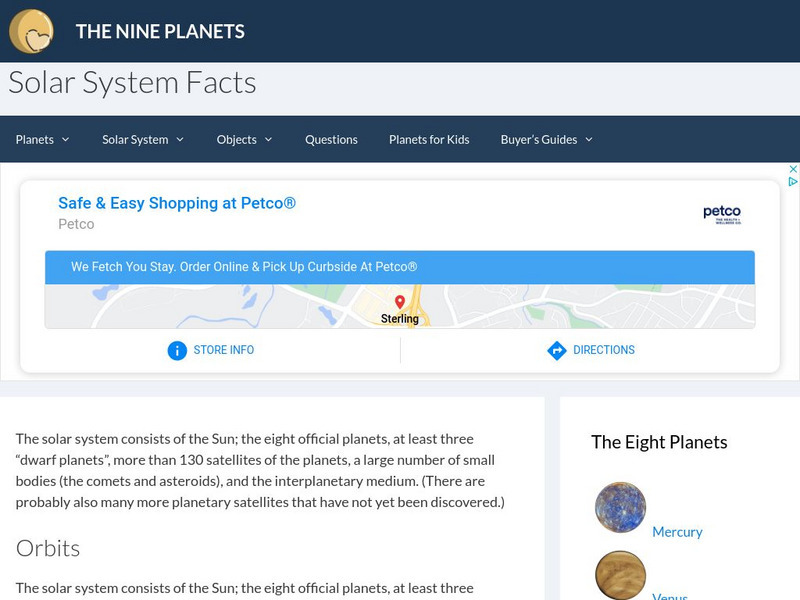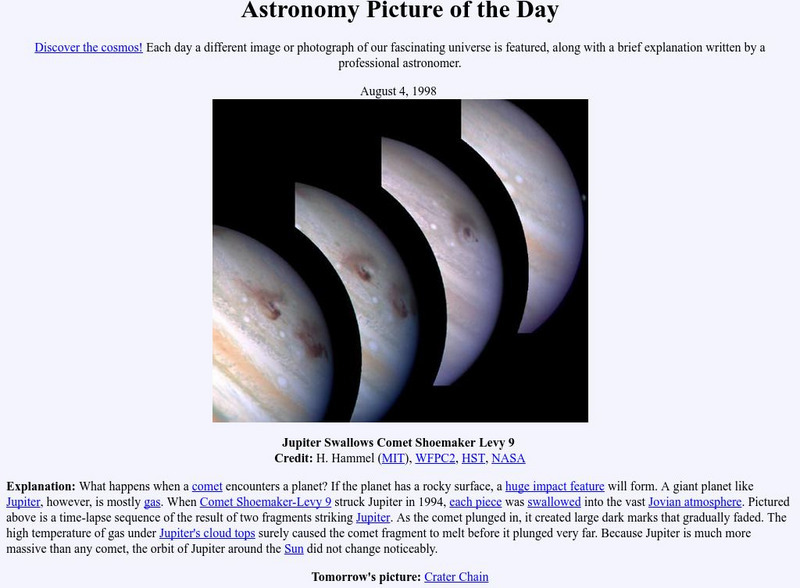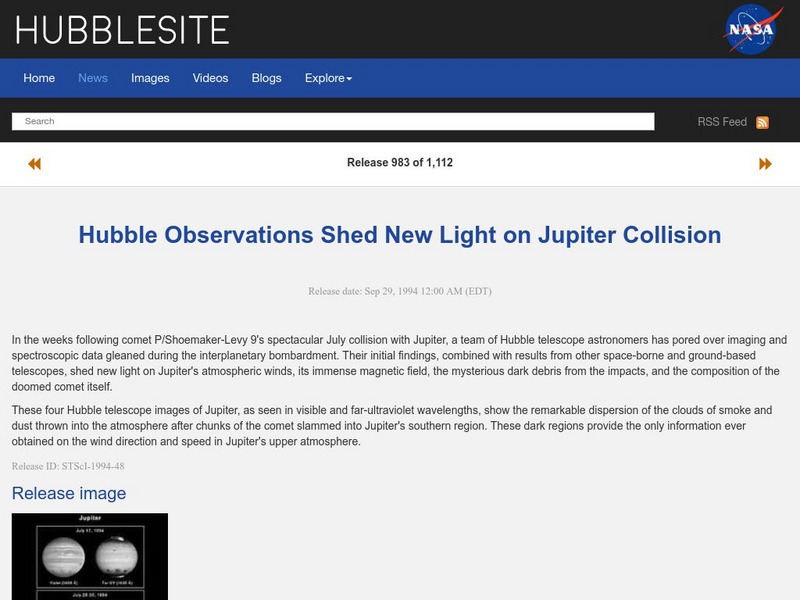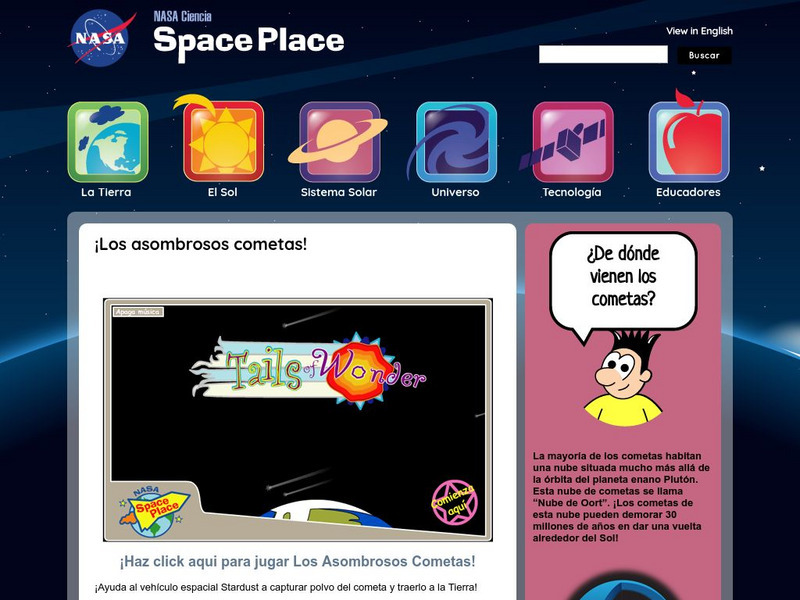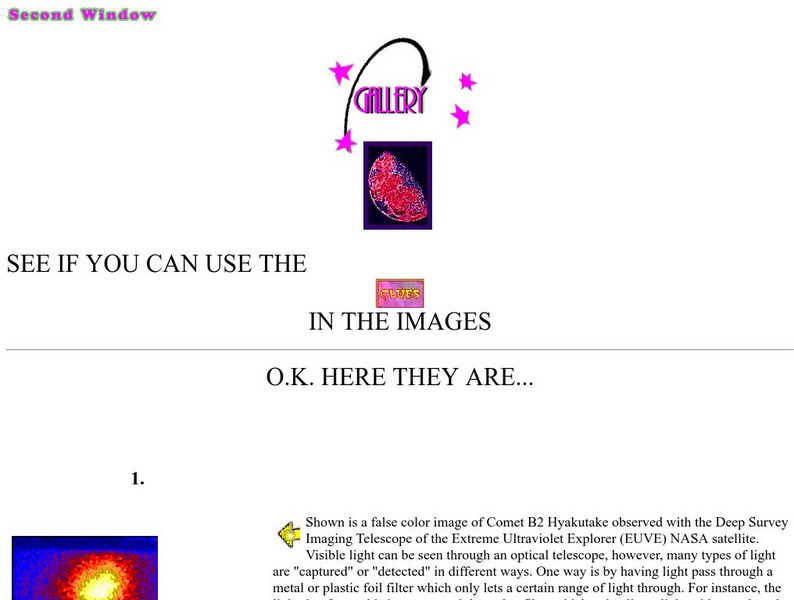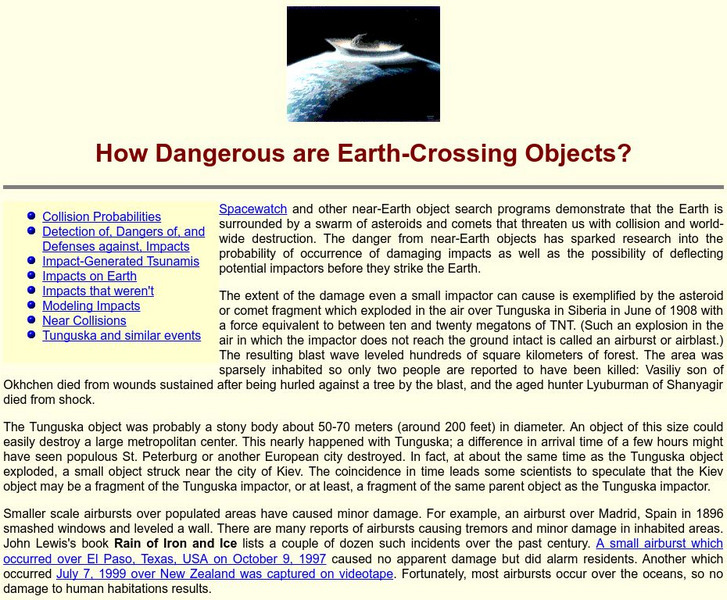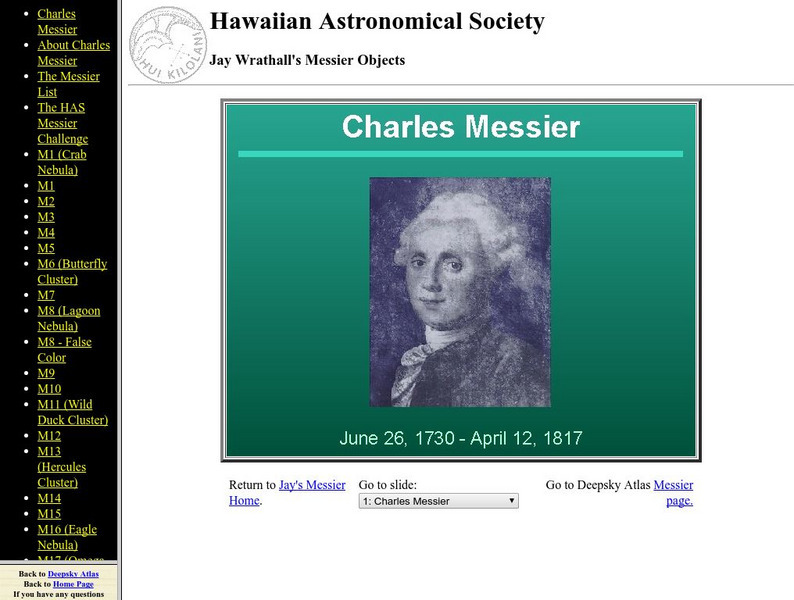Cosmos 4 kids
Cosmos4 Kids: Solar System Details: Asteroids
Learn about asteroids. What are they? What is their structure? Difference between asteroids and comets? The brief, to the point text makes this site most suitable for the younger researcher.
E-learning for Kids
E Learning for Kids: Science: Antarctica/ What Are the Different Parts of the Universe?
In this lesson, students learn about objects in the universe, including constellations, planets, meteors, asteroids, and comets.
E-learning for Kids
E Learning for Kids: Science: Seychelles: What Is the Solar System?
In this lesson, students learn about the planets, their moons, asteroids, comets, and dwarf planets in our solar system.
National Earth Science Teachers Association
Windows to the Universe: Origin of Jupiter's Rings
University of Michigan and Windows to the Universe offers information showing that with the help of the Galileo spacecraft, scientists figured out that the rings are made from dust that was kicked off of the small moons surrounding...
Nine Planets
The Nine Planets: Small Bodies
This site explores the smaller bodies in the solar system, namely the various asteroids and comets. Links are also provided for additional information on related subjects.
A&E Television
History.com: The Space Race: Interactive Universe
A virtual journey through space offers photos and facts about Earth and its neighboring planets, comets, other celestial bodies of the Solar System, and the Milky Way and Andromeda galaxies.
Space Telescope Science Institute
Hubble Site: Solar System Images
A listing of clickable images of objects in the Solar System from the Hubble telescope that includes the following: Venus, Mars, Jupiter, Jupiter's satellites, Saturn, Saturn's rings and satellites, Uranus, Uranus' rings and satellites,...
California Institute of Technology
Spitzer Science Center: Helix Nebula
Under the heading, "Comets Kick up Dust in Helix Nebula" this site a particular nebula in the constellation Aquarius. In addition to an image, the site provides information on nebulas and star systems.
Nine Planets
The Nine Planets: An Overview of the Solar System
A detailed overview of the history, mythology, and current scientific knowledge of each of the planets and moons in the solar system.
NASA
Nasa: Stardust: Be a Spacecraft Engineer
Some interesting projects for students interested in the space program.
NASA
Nasa: Astronomy Picture of the Day:collision at Jupiter
What happens when a snowball hits a huge ball of gas? When Comet Shoemaker Levy 9 hit Jupiter, it was swallowed up in the atmosphere, leaving huge temporary impact scars. Here is an image that shows the large dark marks and how they...
Space Telescope Science Institute
Hubblesite: Observations Shed Light on Jupiter Collision
This site from Hubblesite of the National Aeronautics and Space Administration provides basic information and photographs of the collision of Comet Shoemaker-Levy 9 with Jupiter. A good site to check out on the subject.
NASA
Los Asombrosos Cometas!
Engage in the quest to help the Stardust spacecraft capture comet dust and bring it back to Earth. Each time you answer a question correctly from the article, you move closer to the comet. Students enhance reading comprehension skills...
Australian Broadcasting Corporation
Australian Broadcasting Corporation: News in Science: Mars as You've Never Seen It Before
From ABC News in Science, this article charts findings of the Rosetta ("Europe's comet-chasing spacecraft") as it took photographs of Mars from a close-up perspective.
University of California
Center for Science Education: Gallery
A gallery of astronomy images which depict galaxies, comets, the moon, planets, nebulae, supernovae as seen in various regions of the electromagnetic spectrum. Each image in the gallery is described. Fascinating!
Other
Pibs: How Dangerous Are Earth Crossing Objects?
This resource page discusses how close Earth is to a collision with other objects. This page gives helpful information about comets and asteroids as well links to other resources on the topic.
Other
Has: Charles Messier
Brief, concise facts about Charles Messier and his catalog of comets, galaxies, and other astronomical bodies. Included are photographs of each of the 110 objects listed in his catalog.
Ducksters
Ducksters: Astronomy for Kids: Glossary and Terms
Kids learn about the glossary and terms for the science of astronomy including words and definitions such as asteroid, comet, meteoroid, galaxy, eclipse, etc.
Other
Usc News: Pnas: Topper Site in Middle of Comet Controversy
The disagreement between those who theorize that Clovis man was the first to inhabit North America and those who beleive that there was a pre-Clovis culture continues even today. Archaeologists have found evidence of pre-Clovis points at...
Other
Kid Power: Astronomy for Kids
Young children can find facts about the Solar System, the Sun, meteorites, stars, galaxies, planets, our moon, comets, asteroids, and space exploration. Pages offer clear photos and bullet-point information, which is easy to read and...
ClassFlow
Class Flow: Solar System Jeopardy
[Free Registration/Login Required] This flipchart provides a quiz with mostly multiple choice questions specific to planets, comets, space travel, and our moon.
NASA
Nasa Space Place: Asteroid or Meteor: What's the Difference?
Learn the difference between asteroids and comets, meteoroids and meteorites, and more!
NASA
Nasa: Comet Shoemaker Levy
This site from NASA, Jet Propulsion Lab, provides an extensive look at hundreds of photos and images of space and planets taken from various observatories from around the world. Links are provided throughout as well for additional...
Curated OER
Nasa: Space Place: Rosetta Lander
An artist's rendering of the Rosetta lander on Comet Churyumov-Gerasimenko.
Other popular searches
- Comets and Meteors
- Asteroids Comets and Meteors
- Comets and Asteroids
- Stars. Comets
- Comets Meteors Asteroids
- Comets and Meteors Videos
- Comets Asteroids
- Comets and Orbits
- Comets Asteroids Meteoroids
- Comets, Meteors, Asteroids
- Comets,meteoroids, Asteroids
- Moons, Comets, Asteroids









